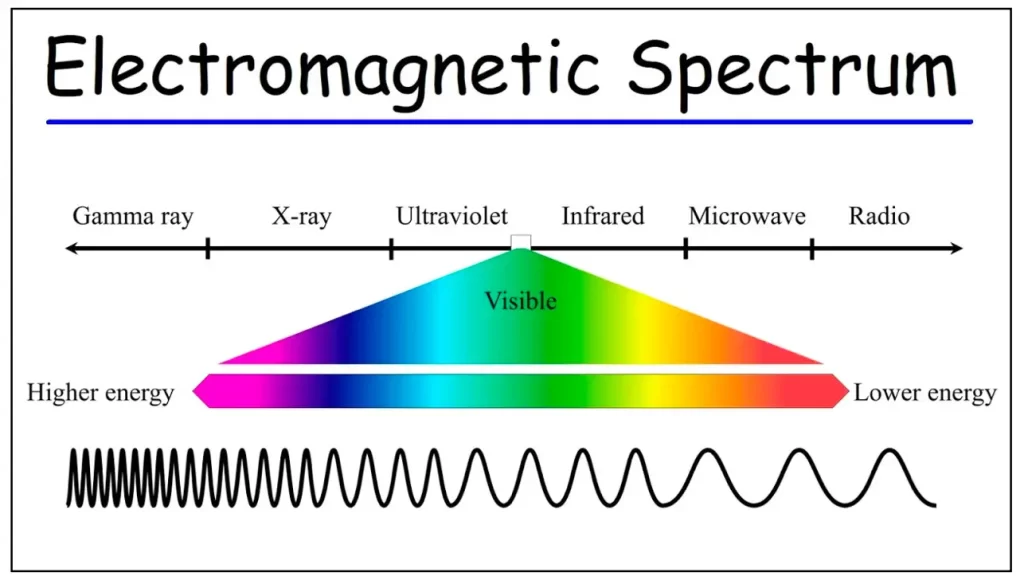The electromagnetic spectrum is a vast and intricate system that encompasses all forms of electromagnetic radiation, ranging from the longest radio waves to the shortest gamma rays. This spectrum plays a fundamental role in our understanding of the universe, influencing various aspects of science, technology, and everyday life. In this article, we will delve into the intricacies of the electromagnetic spectrum, exploring its components, properties, and applications.
Components of the Electromagnetic Spectrum:

The electromagnetic spectrum is traditionally divided into several regions based on the wavelength or frequency of the electromagnetic waves. These regions include:
Radio Waves:
Wavelengths: Longest in the spectrum, ranging from millimetres to hundreds of kilometres.
Applications: Broadcasting, communication, radar, and medical imagin
Microwaves:
Wavelengths: Shorter than radio waves, ranging from millimetres to a few centimetres.
Applications: Microwave ovens, satellite communication, and certain types of radar.
Infrared Radiation:
Wavelengths: Between microwaves and visible light, ranging from a few millimetres to about 700 nanometers.
Applications: Thermal imaging, remote sensing, and communication.
Visible Light:
Wavelengths: Approximately 400 to 700 nanometers.
Applications: Human vision, photography, and optical communication.
Ultraviolet Radiation:
Wavelengths: Shorter than visible light, ranging from about 10 to 400 nanometers.
Applications: UV sterilisation, medical treatments, and astronomy.
X-rays:
Wavelengths: Ranging from 0.01 to 10 nanometers.
Applications: Medical imaging, industrial inspection, and astrophysics.
Gamma Rays:
Wavelengths: Shortest in the spectrum, less than 0.01 nanometers.
Applications: Medical treatments, nuclear medicine, and astrophysics.
Properties of Electromagnetic Waves:
Understanding the properties of electromagnetic waves is crucial for comprehending their behaviour and applications. Key properties include:
Wavelength and Frequency:
Inversely proportional: Shorter wavelengths correspond to higher frequencies and vice versa.
Speed of light: Electromagnetic waves travel at the speed of light, approximately 3 x 10^8 meters per second in a vacuum.
Electromagnetic Spectrum in Everyday Life:
Everyday technologies like radio, television, and microwave ovens rely on specific regions of the electromagnetic spectrum.
Modern communication systems, such as Wi-Fi and cellular networks, utilise radio waves and microwaves.
Applications in Science and Technology:
Astronomy:
Observing celestial objects in various wavelengths allows astronomers to gather diverse information about the universe.
Different regions of the spectrum reveal unique details, from radio signals emitted by distant galaxies to gamma-ray bursts from supernovae.
Medical Imaging:
X-rays and gamma rays are employed in medical imaging techniques such as X-ray radiography, computed tomography (CT), and positron emission tomography (PET).
Communication:
The entire spectrum is crucial for communication, with radio waves for broadcasting, microwaves for satellite communication, and optical fibres for high-speed data transmission.
Remote Sensing:
Infrared and microwave regions are extensively used in remote sensing applications, including weather monitoring, environmental studies, and agricultural assessments.
Conclusion:
The electromagnetic spectrum is a captivating and indispensable aspect of our world, permeating various fields of science and technology. Its diverse regions and properties empower us to explore the cosmos, diagnose medical conditions, communicate seamlessly, and much more. As technology advances, our understanding and utilization of the electromagnetic spectrum continue to evolve, unlocking new possibilities and discoveries that shape the future of science and innovation.




